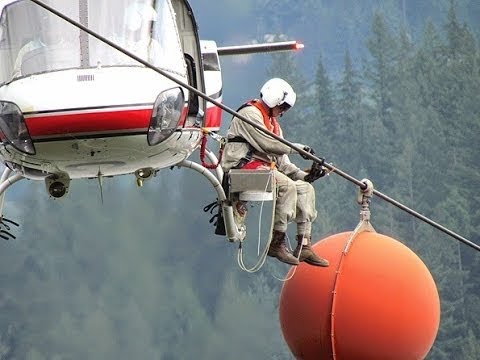The Importance of Powerline Inspection in Mexico
In Mexico, the inspection of powerlines is a task of vital importance to ensure the continuous delivery of electricity to homes and industries across the nation. As a country prone to natural disasters such as hurricanes and earthquakes, the integrity of the electrical infrastructure is often at risk. Regular powerline inspections help to identify potential issues before they lead to power outages or more severe consequences.
Ensuring Reliable Electricity Supply
The reliability of electricity supply is crucial for the daily life and economic activity of millions of people. In Mexico, with its rapidly developing economy, maintaining a consistent power supply is not only a matter of convenience but also a key factor in sustaining economic growth. Powerline inspections carried out by helicopters provide a quick and efficient way to assess the health of the electrical grid and to prevent unplanned interruptions that could disrupt daily life and business operations.
Enhancing Safety and Reducing Hazards
Another significant aspect of powerline inspection is enhancing public and worker safety. Damaged or poorly maintained powerlines can pose serious hazards, leading to fires, electrocutions, or other accidents. Through aerial inspections, potential hazards can be detected safely and without the need for workers to be put in dangerous positions. This proactive approach helps to avert accidents and protects not only the workers but also the surrounding communities.
Cost-Effective Maintenance Planning
Helicopter inspections provide valuable data that enable energy companies to plan maintenance and repairs more effectively. By using helicopters to surveil extensive areas of powerlines, companies can allocate their resources more efficiently, prioritizing repairs that are most urgent. This method helps avoid costly emergency fixes and minimizes the downtime required for maintenance, ensuring that the electrical grid operates smoothly with fewer interruptions.
Dealing with Mexico’s Challenging Terrain
Mexico’s varied terrain, which includes mountains, forests, and urban areas, presents unique challenges for powerline inspection. Helicopters are particularly suited to this task as they can navigate difficult-to-reach areas and provide a clear vantage point for inspectors. This capability is critical for the inspection of remote and hard-to-access powerlines, ensuring that every part of Mexico’s electrical grid is monitored and maintained.
Maintaining the powerlines through regular helicopter inspection is a critical service that supports the energy infrastructure in Mexico. By using helicopter inspections to oversee the condition of powerlines, Mexico can address the challenges of its diverse landscape, ensure safety, and maintain the reliability of its electricity supply, all of which are integral to supporting the nation’s growth and prosperity.
Helicopter Services for Efficient Powerline Inspection
Powerline inspection is a critical task that ensures the reliable distribution of electricity across vast areas. In Mexico, where the terrain can vary from dense urban areas to remote and rugged landscapes, helicopter services have become the go-to solution for efficient powerline inspection. This aerial approach offers a unique vantage point, enabling technicians to cover large expanses of powerlines in significantly less time than traditional ground-based methods.
Utilizing high-tech equipment, helicopters employed for powerline inspections in Mexico are often equipped with specialized cameras, including thermal and high-resolution video cameras. These tools allow for the detailed analysis of powerlines and their associated structures, detecting potential issues such as overheating connections, wear and tear on cables, or vegetation encroachment that poses a risk to the integrity of the electricity network.
Helicopter services in Mexico are also particularly adept at performing inspections following natural disasters, such as hurricanes or earthquakes, when powerlines are most vulnerable. The speed at which helicopters can be deployed allows for rapid response times, ensuring that any damages are quickly identified and addressed, minimizing the downtime for essential services and reducing the potential for extended power outages.
Furthermore, safety is a prominent concern when it comes to powerline inspection. Helicopter services reduce the risk to inspection personnel by avoiding the need for workers to climb poles or navigate difficult terrain. This aerial method of inspection enhances safety by providing a remote inspection capability, which is especially beneficial in Mexico’s more inaccessible areas or regions with heightened security risks.
The integration of advanced data analytics software with imagery and information gathered via helicopter also supports the predictive maintenance of powerlines in Mexico. By analyzing historical data and inspection results, utility companies can prioritize maintenance and repair activities, focusing on areas identified as high-risk. This proactive approach can prevent outages before they occur, emphasizing the critical role helicopter services play in maintaining Mexico’s electrical infrastructure’s resilience and efficiency.
Advantages of Using Powerline Helicopters for Inspection Tasks
Powerline inspection is an essential task to ensure the integrity and functionality of a country’s electrical grid. Helicopters equipped for this job offer several distinct advantages over traditional ground-based inspection methods. In Mexico, with its diverse landscapes ranging from deserts to mountains, employing helicopters for powerline inspections is particularly beneficial. In this section, we’ll explore the advantages of using powerline helicopters for these critical inspection tasks.
Enhanced Accessibility
Helicopters are inherently agile and capable of accessing remote or difficult-to-reach areas. This quality is essential in Mexico, where power lines often traverse rugged terrains and isolated regions. Instead of deploying ground crews that must navigate challenging and sometimes dangerous paths, helicopters can fly directly to the inspection site, saving time and reducing the risk of accidents or injuries.
Speed and Efficiency
Time is a vital factor when it comes to the maintenance of power lines. Helicopters significantly reduce the time required for inspections, as they do not have to contend with ground obstacles or traffic. They can quickly travel between towers and cover vast stretches of lines in a fraction of the time it would take a ground crew. This rapid inspection capability means that any potential issues can be identified and addressed sooner, potentially preventing power outages or more extensive damage.
Detailed Aerial Perspective
Performing inspections from the air provides a unique vantage point that ground crews simply cannot replicate. Helicopter pilots can hover and maneuver to get the best angles for visual inspections, and the use of specialized equipment such as high-resolution cameras and LIDAR enables the capture of detailed images and data. From their aerial perspective, inspectors can spot issues like damaged cables, worn insulators, or vegetation encroachment that may not be visible from the ground.
Cost-Effectiveness Over the Long Term
Although the upfront cost of helicopter inspections may be higher than ground-based approaches, the long-term savings can be significant. By providing rapid detection of potential issues, helicopters can prevent the costly repairs and outages that might result from undetected problems. Additionally, the decrease in man-hours needed to cover the same area and the reduction in risk of injuries or fatalities result in overall cost savings for utility companies. In Mexico’s evolving energy sector, the economic efficiency of powerline helicopter inspections is an advantage that cannot be overlooked.
How Powerline Helicopters Enhance Safety and Reliability
In the diverse landscapes of Mexico, the maintenance and inspection of power lines are crucial for ensuring the uninterrupted distribution of electricity. Powerline helicopters are at the forefront of enhancing safety and reliability in this sector. These specialized aircraft are fitted with advanced equipment that enables them to perform a range of tasks that would be difficult, if not impossible, for ground crews to handle.
Firstly, helicopters provide a unique advantage when it comes to the regular inspection of power lines. They offer an aerial perspective that allows for rapid identification of potential issues before they escalate into more significant problems. Inspectors can closely observe the lines and surrounding vegetation, ensuring that any risks of interference are mitigated, which in turn reduces the likelihood of power outages and enhances the overall reliability of the power grid.
Another critical aspect is the ability of powerline helicopters to access remote and inhospitable areas where traditional vehicles cannot reach. The rugged terrain and dense forestry of some Mexican regions can pose significant challenges to ground crews. Helicopters bypass these obstacles with ease, ensuring that even the most isolated power lines are regularly maintained and any necessary repairs are swiftly addressed.
Safety for maintenance crews is another paramount benefit of using helicopters for power line operations. By using these aircraft, linemen are not exposed to the hazardous conditions found at high elevations or near high-voltage lines. Helicopters can hover and provide a stable platform from which workers can perform their tasks, thus minimizing the risk of accidents that are associated with traditional methods of powerline maintenance.
Finally, the deployment of powerline helicopters is often associated with minimizing environmental impact. Traditional ground-based maintenance can lead to soil disruption and vegetation damage. Helicopters, on the other hand, leave a much smaller footprint, thus preserving the natural beauty and ecological balance of Mexico’s landscapes while still ensuring the integrity of the power transmission infrastructure.
Case Studies: Successful Powerline Inspections by Helicopter
In Mexico, the vast and rugged terrain presents unique challenges for utility companies when it comes to maintaining and inspecting powerlines. Traditional ground-based methods are time-consuming, often less efficient, and sometimes even impossible due to the geography. However, the use of helicopters has revolutionized these inspections, offering a faster, more flexible solution that significantly reduces the risk and time associated with this critical task. Here, we explore a few case studies where helicopters have enabled successful powerline inspections.
Sierra Madre Occidental Operations
In one notable case, helicopters were employed for the inspection of powerlines stretching across the Sierra Madre Occidental, a region known for its steep slopes and high peaks. The inspection team utilized the aerial advantage to quickly detect and assess issues that would have taken weeks to identify from the ground. Inspectors were able to record high-resolution images of the infrastructure, leading to the detection of potential problems before they could cause power outages.
Flood-Affected Areas in Southern Mexico
Another instance where helicopter inspections proved indispensable was in the aftermath of heavy flooding in southern Mexico. With access roads washed away and terrain rendered treacherous, helicopters offered an immediate solution for powerline inspection and repair teams. This rapid response capability was crucial in restoring power to thousands of residents and mitigating the potential for further disaster in flood-stricken communities.


